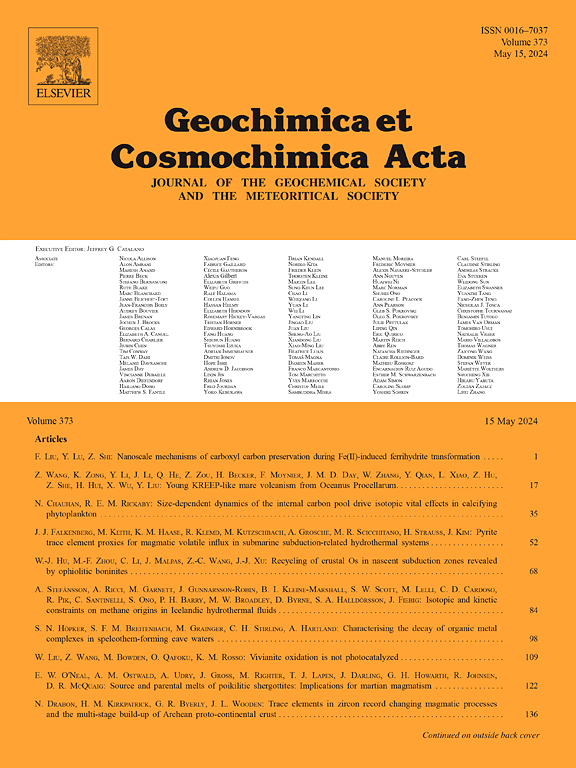Carbonation processes in Oman peridotite: temperature-dependent reactions and Mg isotope composition of reacting fluids
IF 5
1区 地球科学
Q1 GEOCHEMISTRY & GEOPHYSICS
引用次数: 0
Abstract
The study of natural analogues of CO2 mineral sequestration combined with the experimental quantification of carbonation reactions constitutes a fundamental approach to understand the spatial and structural distribution of carbonated bodies and the time scales by which large amounts of CO2 can be stored in solid form into geologic formations. To better quantify the carbonation rates of ultramafic rocks and study the evolution of dissolved Mg isotope composition during their interaction with CO2-rich fluids, a series of batch carbonation experiments using a partially serpentinized harzburgite from the Semail ophiolite (Oman) was conducted at 90–180 °C and at constant CO2 partial pressures (∼ 15–20 bar). The yield of the carbonation reaction increased from ∼ 0 at 90 °C to a maximum of 31 mol % at 150 °C, decreasing to 12 mol % at 180 °C over a period of one month. Magnesites containing 3–9 wt% of Fe and silica polymorphs (SiO2(am) and chalcedony) were the main reaction products, with a fraction of secondary Mg-silicates that increased with increasing temperature, significantly reducing the carbonation extent at 180 °C. The aqueous fluid became progressively enriched in heavy isotopes with the progress of the carbonation reaction. The apparent Mg isotope fractionations between the rock and bulk fluid (Δ26Mg = δ26Mgsolid − δ26Mgfluid) varied from −1.6 ‰ at 120 °C to −0.9 ‰ at 180 °C, consistent with the preferential uptake of 24Mg by carbonate minerals and the decrease of isotope fractionation with increasing temperature. The average magnesite isotope compositions (−1.6 ‰ ≤ δ26Mg ≤ -0.3 ‰) derived from mass-balance calculations were found to be within the range of δ26Mg values reported for Oman listvenites, suggesting that the carbonation processes in this geological unit took place within the temperature range considered in this study (∼120–180 °C).
Comparison of experimental results with observations of a well-studied natural analogue provides new indications on the optimum conditions for the development of CO2 sequestration methods in peridotites, or ex situ carbonation techniques using ultramafic minerals. The observed evolution of the Mg isotopic composition of the fluid also suggests that the use of Mg-isotopes could be an effective tool to monitor the spatial and temporal progress of carbonation reactions during field-scale CO2 storage operations in ultramafic rocks.
阿曼橄榄岩的碳酸化过程:温度依赖性反应和反应流体的Mg同位素组成
对二氧化碳矿物封存的天然类似物进行研究,并结合碳酸化反应的实验量化,是了解碳酸化体的空间和结构分布以及大量二氧化碳以固体形式储存到地质构造中的时间尺度的基本方法。为了更好地量化超镁质岩石的碳酸化速率,并研究其与富CO2流体相互作用过程中溶解Mg同位素组成的演化,在90-180°C和恒定CO2分压(~ 15-20 bar)下,利用Semail蛇绿岩中的部分蛇纹岩进行了一系列间歇式碳酸化实验。在一个月的时间里,碳化反应的产率从90°C时的~ 0增加到150°C时的最大31 mol %,在180°C时下降到12 mol %。主要反应产物为含铁量为3 ~ 9 wt%的菱镁矿和硅晶多态物(SiO2(am)和玉软石),随着温度的升高,次生镁硅酸盐的含量增加,在180℃时显著降低了碳化程度。随着碳酸化反应的进行,含水流体的重同位素逐渐富集。岩石与体流体(Δ26Mg = δ26Mgsolid - δ26Mgfluid)的Mg同位素分馏值在120℃时为- 1.6‰~ 180℃时为- 0.9‰,与碳酸盐矿物对24Mg的优先吸收和同位素分馏值随温度升高而降低相一致。通过质量平衡计算得出的菱镁矿平均同位素组成(−1.6‰≤δ26Mg≤-0.3‰)在阿曼听石的δ26Mg值范围内,表明该地质单元的碳酸化过程发生在本研究考虑的温度范围内(~ 120-180℃)。
本文章由计算机程序翻译,如有差异,请以英文原文为准。
求助全文
约1分钟内获得全文
求助全文
来源期刊

Geochimica et Cosmochimica Acta
地学-地球化学与地球物理
CiteScore
9.60
自引率
14.00%
发文量
437
审稿时长
6 months
期刊介绍:
Geochimica et Cosmochimica Acta publishes research papers in a wide range of subjects in terrestrial geochemistry, meteoritics, and planetary geochemistry. The scope of the journal includes:
1). Physical chemistry of gases, aqueous solutions, glasses, and crystalline solids
2). Igneous and metamorphic petrology
3). Chemical processes in the atmosphere, hydrosphere, biosphere, and lithosphere of the Earth
4). Organic geochemistry
5). Isotope geochemistry
6). Meteoritics and meteorite impacts
7). Lunar science; and
8). Planetary geochemistry.
 求助内容:
求助内容: 应助结果提醒方式:
应助结果提醒方式:


